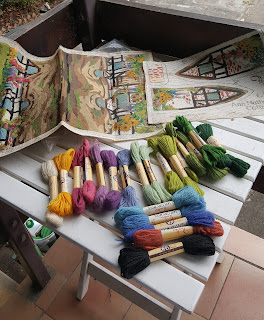 |
| This photo and a small set of instructions were part of the original kit. |
 |
| All the wools and the parts of the tea cosy. |
The coloured skiens of wool were in an attractive and harmonious range of colours range of shades. I was hooked from the moment I saw it .
It was grubby and yes all the wool was binned as there were insects that had lived amongst it.
However a large tea cosy and of such a quaint type was not to be passed over!
For $8 it was mine. Oh joy.
Now a day later and some time spent in research I can tell you a little about it.
The manufacturer was William Briggs in Bolton England. The founder had in 1874 applied for and been granted a patent for wax paper pattern transfers using a hot iron.
William Briggs and Co. Became famous for traced linens and heat transfer prints. This style of printing is still used today. After World War 1 this manufacturer produced kits under the brand names of Anchor, Fleur de Lise and Penelope . This kit is a Penelope kit called "Ann Hathaway's Cottage. All the wools were labled made by William Briggs &Co. It may have been their age and desication, but they were possibly not as good in terms of quality as the wool available from their rival DMC.
The canvas has pairs of threads and is there for also known as "penelope" canvas. A thin black out line of the cottage was printed onto the canvas and then painted by hand with water colours. This was discovered by testing the paint.
I am not sure when canvases for needlepoint and tapestry were first printed in colour. That this is in water colour could indicate a pre 1930s date. I have only one other early hand painted canvas of a rural Australian scene which would have been painted using thinned oil paints.
A folded ribbon has been tacked along all the cut edges of the canvas to prevent further loss of the edge. It appears the smaller section with the ends of the cottage would have been part of the original length. Trimming this away and the narrow margin all around shows a lack of forethought.
This was compounded by not following the directions regarding the thatched roof. The roof is padded with tramme and over stitched. Instead, on one side it has been completed in half cross tent stitch- a miserly use of wool which covers, but does not pad out the image. The roof is indistinguishable from the rest and is flat instead of textured. The other side of the roof has been un picked (very carefully) and the tramme work etc will be done. This side has the front door and garden. The flowers will be done in petit point as may the windows.
I will post more photos of the results.